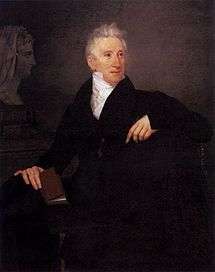Leopoldo Cicognara
| Count Leopoldo Cicognara | |
|---|---|
 Leopoldo Cicognara; Portrait by Ludovico Lipparini (1825) | |
| Born |
1767 Ferrara, Italy |
| Died |
1834 Venice, Italy |
| Occupation | Art Historian |
Count Leopoldo Cicognara (17 November 1767, in Ferrara – 5 March 1834, in Venice) was an Italian art collector and art historian.[1]
Biography
Cicognara resided for some years at Rome, where he devoted himself to painting and the study of antiquities and galleries; later he visited Naples and Sicily, and published at Palermo one of his first works of poetry. After exploring the island, he relocated to Florence, Milan, Bologna and Venice, acquiring archaeological knowledge of these and other cities.
In 1795, he moved to Modena and was for twelve years engaged in politics, becoming a member of the legislative body, a councilor of state, and minister plenipotentiary of the Cisalpine Republic at Turin. Napoleon decorated him with the Iron Crown; and in 1808 he was made president of the Accademia di Belle Arti di Venezia, a post in which he worked for a number of years.
In 1808, his treatise Del bello regionamenti appeared, dedicated in glowing terms to Napoleon. This was followed by his magnum opus, the Storia della scultura dal suo risorgimento in Italia al secolo di Napoleone, in the composition of which he had been encouraged and advised by Wilhelm Schlegel. The book was designed to complete the works of Winckelmann and D'Agincourt, and is illustrated with 180 plates in outline.
In 1814, after the fall of Napoleon, Cicognara was patronized by Francis I of Austria, and between 1815 and 1820 published, under the auspices of that sovereign, his Fabbriche più cospicue di Venezia, two folios, containing some 150 plates. Charged by the Venetians with the presentation of their gifts to the Princess Caroline Augusta of Bavaria at Vienna, Cicognara added to the offering an illustrated catalogue of the objects it comprised; this book, Omaggio delle Provincie Venete alla maestri Carolina Augusta, has since become of great value to bibliophiles.
Reduced to poverty by these splendid editorial speculations, Cicognara fell out of imperial favor for his political opinions. He left Venice for Rome; his library was offered for sale; and, in 1821 he published at Pisa a well-known catalogue of this fine collection, the result of thirty years labor, which, in 1824, was purchased en bloc by Pope Leo XII, and added to the Vatican library. The other works by Cicognara are the Memorie storiche de litterati ed artisti Ferraresi (1811); the Vite de' più insigni pittori e scultori Ferraresi, MS.; the Memorie spettanti alla storia della calcografia (1831); and a large number of dissertations on painting, sculpture, engraving and other kindred subjects. Cicognara's work in the academy at Venice, of which he became president in 1808, had important results in the increase in number of the professors, the improvement in the courses of study, the institution of prizes, and the foundation of a gallery for the reception of Venetian pictures. In 1833, he was elected into the National Academy of Design as an Honorary Academician.
Philipp Fehl and Raina Fehl were the directors of The Leopoldo Cicognara Program at the University of Illinois Library, dedicated to the study and promulgation of literary sources in the history of art, 1987-2007. They cataloged the collection of work found in the Fondo Cicognara at the Vatican Library.
References
- ↑ Sorensen, Lee (2018-02-21). "Cicognara, Leopoldo, Conte". arthistorians.info. Retrieved 2018-04-05.

External links
List of works
- Le belle arti (Ferrara: Per gli eredi di G. Rinaldi, 1790)
- Lettera ad un amico su di alcune attuali controversie giudiciarie e su diverse opinioni degli eruditi intorno al Panteon di M. Agrippa detto la Rotonda (Pisa: Impresso co' caratteri di Firmino Didot, 1807)
- Del bello: Ragionamenti (Florence and Pisa, 1808)
- Storia della scultura dal suo risorgimento in Italia sino al secolo di Napoleone per servire di continuazione alle opere di Winckelmann e di d’Agincourt. Vol. 1, Vol. 2, Vol. 3 (Venice: Venezia: Nella tipografia Picotti, 1813)
- De' propilei e della inutilità e dei danni dei perni metallici nella costruzione degli edifizii (Venice: Nella Tip. di Alvisopoli, 1814)
- Le fabbriche più cospicue di Venezia... (Venice, 1815-1820)
- Catalogo ragionato de’ libri d’arte e di antichità (Pisa: N. Capurro, co'caratteri di F. Didot, 1821)
- Biografia di Antonio Canova, aggiuntivi il catalogo completo delle opere (Venice: G. Missiaglia, 1823)
- Storia della scultura dal suo risorgimento in Italia fino al secolo di Canova: fino al secolo di Canova. Vol. 1, Vol. 2, Vol. 3, Vol. 4, Vol. 5, Vol. 6, Vol. 7, Vol. 8 (Prato: Frat. Giachetti, 1823-1825)
- Memorie spettanti alla storia della calcografia (Prato, 1831)
| Preceded by - |
President of Ateneo Veneto 1811–1817 |
Succeeded by Francesco Aglietti |